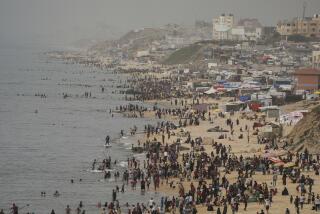Tollways Give a New Meaning to ‘Pay As You Go’
What is the price you’re willing to pay for a breezier commute?
For Mary Monise, shelling out $7 each time she travels the 91 Express Lanes -- to whoosh past all those cars stuck in the congested regular lanes -- is well worth it, considering the 20 minutes she can save.
“Would it be nice if the freeways were free? Oh, God, yeah,” said Monise, an Irvine corporate trainer who lives in Corona. “I don’t like paying the higher prices, but I like where I live and where I work. It’s a good trade-off.... You can get home a little earlier.”
Tollways such as the 91 Express Lanes are the wave of California’s transportation future, some advocates say. With Sacramento too financially pinched or unwilling to fund new projects, transportation agencies increasingly are eyeing commuters like Monise as the financiers.
Paying to drive in less congestion is already part of everyday life in Orange County, which has five tollways, including the 91 Express Lanes that extend for 10 miles along the Riverside Freeway.
In San Diego County, Interstate 15’s high-occupancy vehicle lanes have been converted into toll lanes for solo drivers. Carpoolers still drive for free.
Last month, the Metropolitan Transportation Authority adopted a plan to build an 18-mile toll corridor of truck lanes along the Long Beach Freeway, from the harbors to the rail yards of Commerce. The $5.5-billion project, which would also add regular car lanes to the 710, is not yet funded.
But transportation agencies could be doing much more, according to a new study by the Reason Foundation, a nonprofit libertarian group in Los Angeles. The report urges a wider network of tollways in Southern California, including a tunnel through the mountains between Palmdale and Glendale, a truck-way from the ports to Nevada, and toll lanes for hyper-jammed freeways such as the 101 and the 405.
“California is not at all responsibly planning for its growth in highway use. We’re going to have massive increases in car and truck traffic. But there’s no money to do big projects,” said Bob Poole, director of transportation policy for the foundation and a coauthor of the report. “There’s actually a way to do these projects, despite the state being broke, and that’s for the new additions to be paid with tolls.”
The state has not funded any new freeway or transit projects in more than two years, and Gov. Arnold Schwarzenegger has proposed diverting $1.3 billion in transportation funding this year for other uses.
California law also may be deterring tollways, the study found.
The report has sparked mixed reactions.
“You’ve got to pay by the mile in addition to what you’re already paying with the gas tax,” said Jerry Silver, president of Coalition of Freeway Residents, deriding toll lanes as “Lexus roads” that unfairly exclude drivers who can’t afford to pay.
But others said motorists already are paying by wasting time in traffic.
“The state of California is in such a serious state of affairs when it comes to transportation,” said Frank C. Roberts, chairman of the Metropolitan Transportation Authority and the mayor of Lancaster. “I’m not sure what else we can do except for toll roads and toll lanes.”
By 2030, the combined population of Los Angeles, Orange and Ventura counties and the Inland Empire, now 17 million, is expected to reach about 23 million, according to the report. Auto traffic is expected to grow accordingly, by about a third, while truck traffic from the ports will skyrocket by 70%.
Meanwhile, the average rush-hour speed on some freeways -- such as the 405, 101, 14 and 10 -- already has ground down to less than 10 mph, according to the Southern California Assn. of Governments.
The association, which has endorsed the idea of toll lanes, expects “user fees” such as tolls to contribute $60 billion to the region’s transportation programs over the next 25 years.
Some questioned whether the Palmdale-Glendale tunnel called for by the Reason report would be feasible.
To finance the $3-billion tunnel -- which would have four toll lanes in each direction -- the project would be built in two phases: Tolls up to $9 per trip from the first finished phase would pay for the construction of the remaining lanes, Poole said.
Previous studies have found a narrower tunnel to be scientifically possible, but unwise.
“The cost was very high, and there were environmental issues,” recalled Brian Lin, project manager for an MTA study in 2004 on expanding the freeway network in north Los Angeles County, which rejected tunneling as an option. “To me, it’s not real. I don’t think it’s realistic.”
At the very least, others say, the report offers an alternative plan to California’s current course: new projects delayed or stalled for lack of public funding.
“It’s a very good starting point on the issues,” said Doug Failing, district director of Caltrans for Los Angeles and Ventura counties. “I think the state’s ready for that debate.”
More to Read
Start your day right
Sign up for Essential California for news, features and recommendations from the L.A. Times and beyond in your inbox six days a week.
You may occasionally receive promotional content from the Los Angeles Times.






